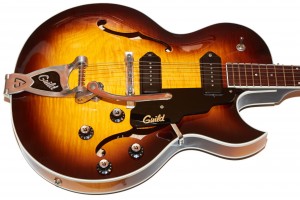
After about 2000 or so, Guild (then owned by Fender) moved production from Westerly, Rhode Island to Corona, California. A lot of people in the Guild community were worried that the legendary quality of Guild guitars would plummet with Fender at the helm, and while Fender did a great job of letting Guild electric guitars die in the long tun, having owned many of each I’m here to tell you that these Corona-made Guilds are every bit the guitar of the Westerly-made models. This guitar is no exception. Let’s find out why.
Introduction
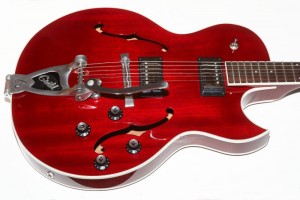
The ’60s Starfire-IIIs came with the coveted Guild mini-humbuckers which produce a wonderful almost chimey sound. Unfortunately for me, the necks on these older models are usually quite small and I quickly discovered that I don’t enjoy playing them. When Guild reintroduced them in the 1990s, they included wider more modern fretboards, making these guitars feel much better in my hands. Add P90s to this guitar and the versatility just goes through the roof.
Finish
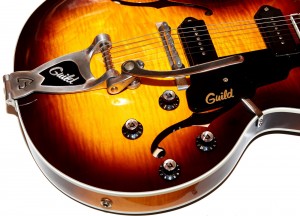
A note about the sunburst colors is in order. If you look at some of these pictures you’ll notice a wonderful reddish (almost bourbon-burst) like quality to the finish. Sadly this does not usually show up in normal light but is brought out by the light of the flash and sometimes by direct sunlight.
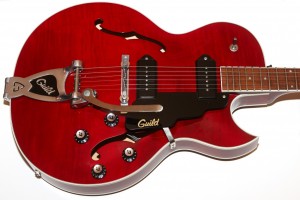
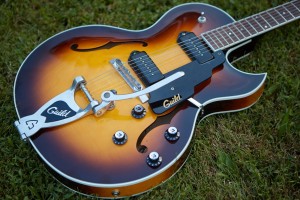
Putting the guitar on its side and letting the sun hit it more directly changes the angle of the light, and the guitar not only displays its beautiful flame, but the red highlights start to show in the finish as well.
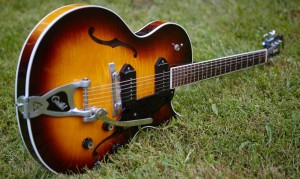
The finish, like all Guilds of this era, is spotless with no problem areas, drips, or other anomalies. Who ever sprayed these guitars knew what they were doing.
Fretboard and Neck
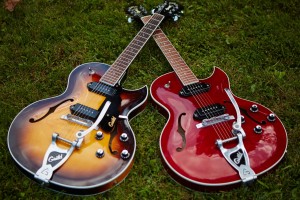
The nut is 1 11/16″ wide and the neck is deep enough that I wouldn’t call it thin while not being overly fat, either. I’ve owned some real base-ball bat necked P90-equipped guitars, and these don’t have that going on but they’re still a bit beefy. While I’m fine with a nice fat neck, I dislike super-thin necks with a passion.
If you look at the picture of the two Starfire-IIIP-90s in the grass, you’ll notice that the fretboard on the sunburst one is a dark color while the red guitar has a very red-tinted color rosewood. I have no idea why this fretboard is so red, but it’s one of the first things I noticed about that guitar when I first got it. I use Fret Doctor on all my fretboards, which often darkens lighter rosewood boards found on less-expensive guitars. It has had no effect on this guitar over repeated applications. I feel no difference between the two and the guitars both sound great, so I stopped caring pretty early on. If you’re a master of rosewood, I’d love to hear your theories as to the differences.
Build Quality
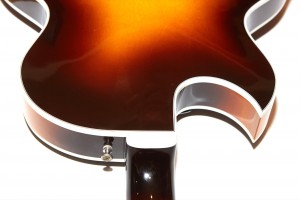
Every seam, every fret, every little detail is exactly how it should be. Even the pics you’ll see when I write about the electronics will show that the inside of the guitar is clean and (dare I say?) pretty. Compared with the gut shot from my review of the Newark Street X-175B, this Starfire is a work of art internally.
Older Guilds are often prone to binding rot, and I’ve seen many of the ’60s and ’70s Guild electrics (mostly Starfires) suffer from this fate. That and shrinking headstock veneers are examples of the older Guild’s few flaws, neither of which I recall seeing on any 1990s or later instruments. Later Westerly and early Fender Guilds are superb instruments.
Pickups
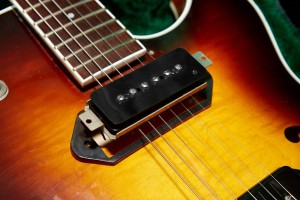
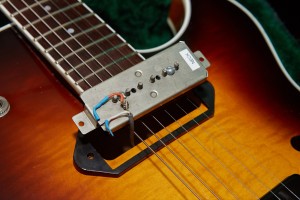
From what I can find, these appear to be dog-ear Seymour Duncan Antiquity P90s without the normal aged covers that these pickups come with, which wouldn’t surprise me because they sound great. When it comes to P90s, I prefer Alnico 2 magnets, which I think gives them that magic rock tone I desire and these pickups deliver the goods in that regard, further solidifying the case for these being Antiquities.
I shimmed the bridge pickup on both of these guitars in order to bring it closer to the strings which I felt worked much better. The bridge position alone felt a little thin and weak compared to the neck position, and this affected the middle position since the two pickups were a bit unbalanced. With the shim, everything is great including the balance between the pickups and the tone with both of them engaged. If you’re not familiar with dog-eared P90 installations, the shims are required because there’s no other way to adjust the height once mounted.
Electronics
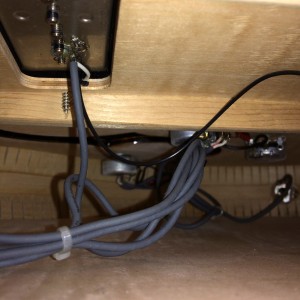
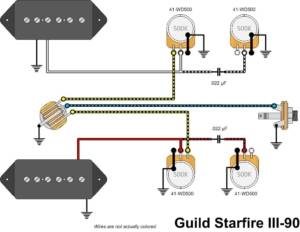
Hardware
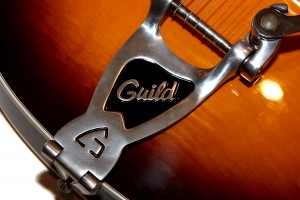
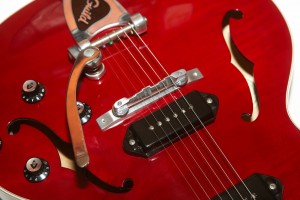
The bridges on these guitars aren’t the greatest things ever, but they work reasonably well. I generally replace my Bigsby-equipped guitars with Compton bridges because I like the tone and the look and they intonate well for my needs, but I haven’t done so with either of these guitars, possibly due to laziness and the fact that the existing bridges function and don’t annoy me like the one on my Gretsch SSLVO did.
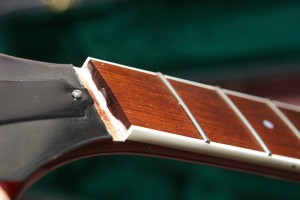
These issues don’t detract from the quality of the guitar because they were things that were done to it by someone who should have probably just let it be. After a couple hundred dollars of professional work, the guitar plays like the fine instrument that it is, even though it still has holes in the bridge. The sunburst Starfire had no problems except for the weak spring which sadly was not completely rectified with a penny.
Sound
These guitars sing when unplugged since they’re basically acoustics without any form of center block or even sound post inside. Well, you don’t see many acoustics with arched maple laminate tops, but you get the idea. They’re almost as much fun to play unplugged as they are into an amp.
My first Starfire III was a red mahogany model from the 1990s with Seymour Duncan pickups. It was a great guitar, but it was too dark for the sound I was chasing, so I ended up selling it. One of the things that attracted me to these P90-equipped Starfire IIIs is the fact that they have single coil pickups which should give a bit more chime while still offering that fat midrange commonly heard with P90s. In my opinion, they deliver this in spades.
These guitars have even more flexibility once you start to dial off the treble with the tone knobs, and even more when you start to fiddle with the individual volume pots in the middle position. I tend to like very thin picks because I like the highs and the attack I get with them, but for comping jazz chords, either fingers or a fatter pick coupled with a bassier setting on the neck pickup and you’ve got yourself a nice thin jazz box.
Since the P90s have a bit of chime to them while retaining a nice fat midrange, these guitars are very versatile. Moreso, in my opinion, than a Starfire III with even Guild HB1s, and I love my HB1s!
Playability
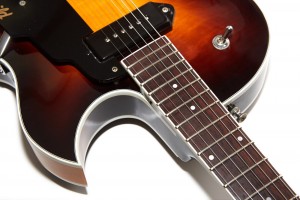
The frets are nice, and are much larger than the ones commonly seen on 1970s era Guilds. The fretwork is excellent, and the fretboard is fast enough to rock on while the neck is thick enough to be much more comfortable than many of the thinner-necked Gretsches I’ve played. I used to have a Gretsch SSLVO (Brian Setzer signature model) that was an outstanding guitar, but the V-Neck never felt quite right to me. The necks on these Starfires is much more like a C-shape, and is much more comfortable to me.
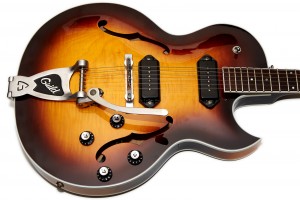
Note that when playing live, or just with the amp up high, that these can be screaming feedback demons that will quickly train you to keep your fretting hand on the strings at all times lest you subject the audience to ear-splitting feedback in short order, and I don’t mean the kind of feedback that slowly builds until you realize that something is wrong. Turn the amp up, take your hands of the strings, and the screaming begins immediately.
Feedback isn’t a design flaw, but rather just a side effect of the guitar being fully hollow. That’s why Guild X170s have sound posts, Setzer Gretsches have trestle bracing, and Starfire IVs have center blocks. Like I wrote above: keep your hands on the strings when you’re not playing and the feedback thing is managed. Besides, if you take your hands of the strings, then you’ll get single-coil buzz, anyway.
Conclusion
I grew up playing in the 1970s and ’80s, and was a hard-core hair-metal spandex-wearing freak of the first order. Actually, I never went in for the spandex thing, but I certainly did have the hair. At any rate, back then I was a super-strat, Floyd Rose forever kind of guy, and here I am reviewing what amounts to a thin-line jazz box. What the hell happened?
Tastes expand, for one, and as I got older it became possible for me to expand my gear horizons because I cut my hair and got a real job. Sadly, becoming a corporate sell-out is what it took for me to afford the nice guitars. Life, it has been said, is not without a sense of irony. I, it has also been said, do not have the skill or talent to make good money playing in a band, as much as I loved doing so.
I’ve owned a lot of guitars in my life, including $3,000 Gretsches bought in my quest for tonal nirvana. The Gretsch sounded great, but I didn’t bond with it like I did with this sunburst Guild Starfire-III-P90. I had a Guild X170T bought for the same reasons, and while I loved the way it played, the pickups (Fender HB1s) left me flat. P90s make the Starfire III an amazing guitar, and I wish Guild would make them again. Hell, I’d love to see an orange X170T with P90s!
For all my talk of jazziness and tweed amps, don’t forget that some of the most iconic songs in rock, namely those recorded by George Thorogood, were recorded on a Gibson guitar that looked just like these do (An ES-125). These things can absolutely rock the house in one song and then do a soft jazz standard the next, and that’s why I love them so much. They’re just so damn versatile. They also look pretty damn good.
These guitars don’t come up for sale very often, and you’ll need to keep an eye out if you want one. I was lucky enough to own two, one of which I got on Craigslist thanks to my network of spies who informed me of its existence only an hour away, and the other I snagged on eBay. In other words, you may need to hunt, and you may need to be patient, and you may need to pay too much, but if you do find one, buy it.
Donate: PayPal Crypto:
ETH: 0x0AC57f8e0A49dc06Ed4f7926d169342ec4FCd461
Doge: DFWpLqMr6QF67t4wRzvTtNd8UDwjGTQBGs

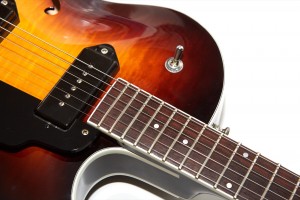
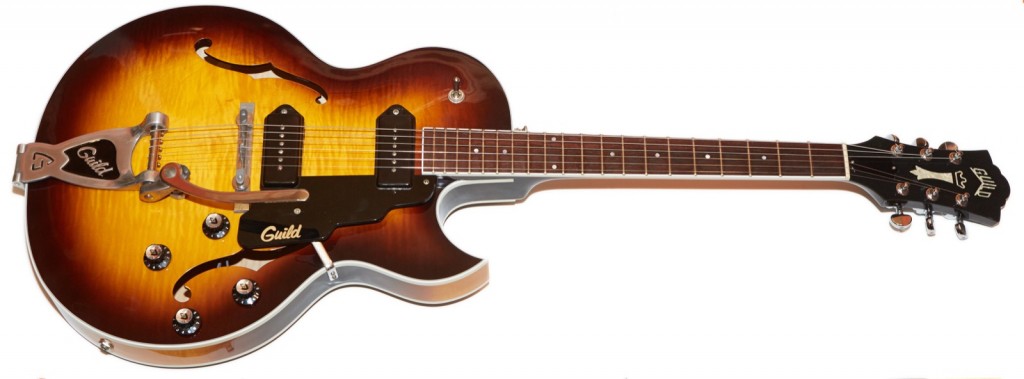
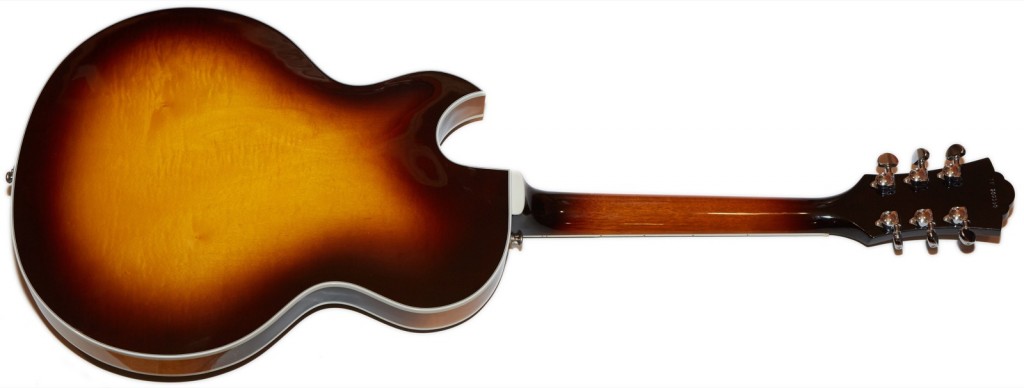
WOW, your Tobacco-Burst Guild is amazing. I like mine, but yours looks like it belongs in a museum, seriously, the one depicted here w/ P90’s is a work of art. Beautiful Burst-Top!! I just picked up one of these Starfire III -P90 last year off Craig’s . . . WHY are these guitars so inexpensive at $1100.00?? I mean, it’s literally a thin-line ARCH TOP, NO CENTER BLOCK, sooooo cool !!!! Don’t worry I don’t plan on Spraying expandable foam inside the F-Holes ~ LOL . . .mine is sun/tobacco burst too also w/ p-90’s. Built 2001, Westerly Guild Plant . . . and it is nearly mint . . . The workmanship is flawless, binding, fit, finish ~ AND It’s an American made guitar, It is as close to custom shop as anyone will get without paying the custom shop price . . . and the guitar plays & sounds amazing and the Bigsby is a bonus as far as i’m concerned. My local Sam Ash carry’s the newer Japanese pro-line Gretsch’s, Falcon’s, Country Gent along with many Electromatic’s and they are all very cool, and ofcourse the coolness factor with Gretsch is near the top if your still Gigging/Playing-Out, cuz I have been looking at the Pro-Line Gretsch’s for almost 2-yr but something told me to wait. So after I saw NEIL GIRALDO (pat benetar’s guitarist) on TV playing a Guild Starfire III I had to investigate. Let’s just say, I would assume NEIL GIRALDO can afford to play / perform with ANY GUITAR ON THE PLANET and he is playing a Guild Starfire III and as I saw and read where he said it is by far the BEST SOUNDING / PLAYING guitar he has ever owned (HIS #1) . . . Really?? Yes!! . . . and that is a quote . . Google it . . . I will never sell my Starfire III P90 . . it is the bomb .. . for how nice it plays & sounds, looks and stays perfectly in tune. The action is almost as LOW has my ’76 Les Paul. The P90’s are beyond cool . . Honestly, if you inscribed GRETSCH on the head stock of this guitar, it would easily sell for > 3K, maybe even 4K . . it’s that good. Shame that Guild could not survive in Westerly producing these awesome guitar’s . . . what was Fender thinking to move production to Corona ~ duh??